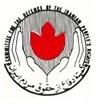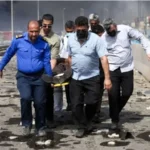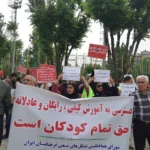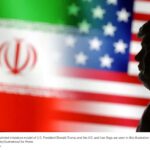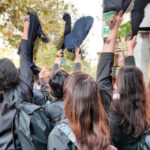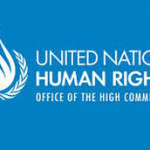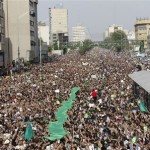
AN INTERVIEW WITHPARANDEH
Iran has exploded in protest following the death of Jîna (Mahsa) Amini, a 22-year-old Kurdish woman detained by “morality police.” We spoke with an Iranian leftist about the mass mobilization and why Western meddling undermines the cause of Iranian democracy.
n the wake of the death of Jîna (Mahsa) Amini, a twenty-two-year-old Kurdish woman who was detained by morality police in Tehran on September 13, massive protests have erupted in Iran. Iranian authorities claim that Amini died of a heart attack and have taken no responsibility for her death, despite her perfect health and witnesses to her beating and abuse. Protesters are demanding an end to compulsory roosari, or hijab, laws; denouncing economic inequality; and even calling for a complete toppling of the theocratic government.
Thousands of protesters have been detained in recent weeks, and internet blackouts have been being implemented to deter organizing and the spread of information. Iranian officials report at least forty dead, while independent sources claim it’s much higher. The scenes have been striking: young people fighting the Iranian Islamic Revolutionary Guard Corps (IRGC); protesters taking over cities; women shaving their heads, lighting their roosaris on fire, and shouting “Down with the Islamic Republic!”
While the protest activity has begun to die down in recent days, people are now turning to work stoppages: students and teachers are on strike, and unions and labor organizations are calling for workers to refuse to show up for work — including those in Iran’s valuable oil industry.
Iran’s theocratic government rose to power in 1979 following a popular revolution against the US-backed Reza Shah, a brutal dictator whose rule was characterized by intense exploitation of workers, repression of dissent, and foreign control over Iran’s oil. While workers and left-wing forces played a central role in the upheaval, Supreme Leader Ruhollah Khomeini and a right-wing clergy took over the government, installing an authoritarian Islamic rule that ended up persecuting those same progressive elements.
The most recent round of protests in Iran broke out in November 2019, in response to massive hikes in gas prices, government mismanagement, and widespread corruption under the Supreme Leader Ali Khamenei and then president Hassan Rouhani. The Revolutionary Guards violently put down these “petrol protests,” potentially killing over a thousand protesters and jailing thousands more. But despite ongoing repression, Iranians are back in the streets.
Parandeh is a twenty-one-year-old Iranian-Azeri artist and writer who has been involved in left-wing politics and labor organizing for the past three years. In a wide-ranging interview, she discusses the horrific death of Amini, shares her perspective on the future of the country, and explains why Western intervention and US sanctions harm, rather than help, the cause of democracy in Iran. For her safety, personal details about her life and her political work have been omitted.
The Death of Jîna (Mahsa) Amini and the Aftermath
SAYEH JAVADI
What was your initial reaction to Jîna’s death?
PARANDEH
I heard about Jîna’s attack as it was happening. The news broke via her brother while she was still in the hospital and had not yet passed. I was eight years old when Neda Agha-Soltan was killed [Agha-Soltan was an activist shot by the Revolutionary Guards during the 2009 Green Movement protests]. Although all the adults in my life attempted to shield me from seeing the video that was constantly being replayed, it was unavoidable and left a profound impact on me. I still remember crying after seeing the video and attempting to hide my sadness from my father.
In the time that has passed, so many people have been killed in the streets during protests, and daughters and wives have been honor-killed and beheaded, with their murderers facing light prison sentences. I don’t think I differ from Iranians globally in being jaded and unaffected by death. So when Jîna was beaten to death, I was angry but not surprised.
SAYEH JAVADI
Did the ensuing protests occur somewhat spontaneously?
PARANDEH
There have always been organization and mobilization in Iran against the leadership. However, I believe these protests are mostly spontaneous, particularly in Iranian Kurdistan. I don’t think anyone could see what happened to Jîna and not feel as though they have to impulsively take to the streets.
Once the police began killing protesters and brutally shot a ten-year-old Kurdish girl, the incentive to protest without a clear plan grew. The people have been discontented for a very long time.
SAYEH JAVADI
What has been the class character of the protests?
PARANDEH
During the petrol protests in 2019, I saw an interview with a bazaari [a poor merchant] who had been on the ground during the Green Movement [which arose out of protests following the 2009 Iranian election]. The reporter asked him about the difference between the petrol protests and the Green Movement and what had changed in the ten-year time span. The bazaari’s response was simple: the Green Movement protests belonged to the upper and middle classes, and the petrol protests belonged to the working class.
Following the petrol protests, we also saw protests dominated by the working class in Khuzestan and laborers on strike around the same time. Anyone who has studied revolutionary movements in history knows that the working class plays an integral role in achieving the demands of any revolution, if it is a genuine movement.The protests we see today began as a working-class movement.
The protests we see today began as a working-class movement. Amini was Kurdish and from Saqqez; Saqqez is majority working class, and Kurds’ standing as an ethnic minority puts them at a greater disadvantage than most.
These protests have expanded past the Kurdish community into many different cities in the country, involving all social classes. In the past, we have seen anti-compulsory hijab protests dominated by upper-middle-class citizens of northern Tehran and other metropolitan areas, so naturally they are a part of these protests as well. But this is one of the first times I have seen different Iranian social classes, ethnic groups, the religious and the secular, come together against a common enemy.
“Workers Make Everything Except for a Living”
SAYEH JAVADI
Students, teachers, and workers are now going on strike, with more unions threatening to do so as well — including workers in the oil industry. What influence and power does the labor movement have in Iran historically?
PARANDEH
This is an incredible development and will boost the morale of all Iranians who doubt the movement is genuine. I saw an incredible image during the Khuzestan protests that depicted working hands with the caption, “Workers Make Everything Except for a Living.” I find this applicable to all societies in which the working class is oppressed, but it is particularly relevant to Iran. Without our farmers, our miners, our steelworkers, and our teachers, Iran would not function.
I would like to provide the words of Sadegh Kargar, an Iranian labor activist:
The oppressed did not become the rulers [after the revolution], they only became more oppressed. [The government has] abolished labor protection laws. . . . As soon as a worker protests, the repressive special forces deal with them. . . . Workers are now flogged, imprisoned, and sentenced to ten years in prison for union issues — for instance, a teacher or a worker who has formed a trade union or defended the rights of teachers or workers to form a union. The rulers now are fledgling capitalists who have followed in the footsteps of the previous ones and are treating the oppressed much worse, more violently, more ruthlessly, and more inhumanely. In fact, what the workers had gained after one hundred years of struggle and effort, they have lost in the Islamic Republic.
Iranian laborers have been going on strike forever, but the earliest record we have of mass labor strikes in contemporary Iran can be traced back to the Constitutional Movement in 1905. The period between 1953 and 1979 was marked by a variety of labor strikes (the biggest one of that time occurring in 1977), and labor rights were an essential principle for the revolutionaries of all backgrounds.Nothing has changed for the average Iranian worker since the times of the Shah, and I personally would consider forty-three years enough time for a revolution’s transitional period to end.
While Imam Khomeini was in exile in Paris, he gave a variety of interviews with Western reporters claiming his leadership would honor and respect Iran’s workers. He was quoted as saying:
Workers in the Islamic Republic will have the right to gather and defend their trade union rights. The deprived workers of Iran, most of whom are pious, poor, and hungry farmers, have the right to fight in any possible and legitimate way to obtain their rights.
When the Islamic revolutionaries came to power, propaganda posters depicting laborers praying were spread throughout the country, accompanied by a quote from Imam Khomeini that read “Islam is the only supporter of the worker” — a bold claim by a man who referred to himself as a reactionary in arguments with leftists and has deprived Iran’s workers the freedom to assemble and executed a majority of the country’s labor organizers.
Nothing has changed for the average Iranian worker since the times of the Shah, and I personally would consider forty-three years enough time for a revolution’s transitional period to end. What we are seeing today on the streets of the country, in most cities and villages, is indicative of that. Prior to these protests, in December of 2021, many of Tehran’s teachers went on strike to demand higher wages and were met with mass arrests. Today they are still fighting for their wages and are standing in solidarity with their students who are protesting — with many university professors resigning their positions.
Iran’s Coordinating Council of Trade Unions and Educators declared September 26 and September 28 as national strike days, requesting teachers and students alike participate. Iranian students in secondary schools are staging their own strikes with the intention of removing compulsory veiling in schools. This movement has been led by the Progressive Female Students in Iran, who are encouraging male students to participate in the strike and to advocate on behalf of their female classmates. Iranian students at fifteen universities have also begun to strike, with larger demands than their younger counterparts, covering government corruption.
In cities across the nation, Iranians of all backgrounds and occupations have been on strike since the end of the first week of protests, most predominantly in Iranian Kurdistan. In Rasht and other Caspian-bordering cities, the public are resorting to a more old-fashioned way of mobilizing, distributing flyers encouraging laborers to participate in the strikes. The Protests Organizing Council of Oil Contract Workers also released a statement, threatening to go on strike so long as the government continues to massacre the public.
The latter is terrifying for the Iranian government, as oil has been our main export since the early twentieth century. This threat and the concern it has caused further display the power laborers hold within the country, despite having little to no rights or representation. I am incredibly proud of our brave workers and their perseverance.
However, there is an unfortunate group of laborers who have not been advocated for or represented nearly enough, and that is Iran’s child laborers. According to reports from 2020, there are ten million child laborers in Iran, with seven million performing in hazardous positions. It is my hope, as this uprising continues, that labor groups inside of Iran and out will provide a voice for the child laborers of our country and that eventually we can officially end child labor in Iran altogether.
I am convinced that the mass participation of laborers in this uprising will move our movement along further and will eventually result in a more ethical, more just, and stronger Iran.
The beautiful thing about these protests is that they are truly dominated by all ages and genders. I saw two very powerful videos recently, one of a Rashti grandmother removing her veil, who said she remembers protesting the removal of Prime Minister Mohammad Mossadegh in 1953, and another of an elderly man standing with his daughter who spoke of being arrested in 1978 by SAVAK during the revolution. [SAVAK was the Shah’s secret police, who targeted, tortured, and executed leftists and other dissidents.]
Both are examples of a generation who saw vast political change in a short period of time and are now fighting again for a future on behalf of their children. I find it incredibly moving. It sends a message to the government: we put you in power, and we will remove you too.
SAYEH JAVADI
These protests come after years of sanctions on Iran and inflation. What kind of economic demands are being made at the current protests?
PARANDEH
Anyone who has lived under sanctions or is familiar with sanctions knows that sanctions only hurt the people, not the government. Sanctions are war, and the sanctions imposed upon Iran by the United States are absolutely evil. However, sanctions are not the main cause of our economic woes — our corrupt government is equally to blame for the economic state of the nation. US sanctions didn’t beat Amini to death, and American sanctions did not shoot that Kurdish ten-year-old girl in the head.
Half of the Iranian population lives below the poverty line, families are going without meat and bread because of the cost of living, and children don’t have milk to drink in the mornings. This is excluding the many child laborers living on the streets and the vast numbers of homeless Iranians who are seeking refuge in empty graves — as reported by the Islamic Republic itself.Sanctions are war, and the sanctions imposed upon Iran by the United States are absolutely evil.
While the population is living under these conditions, members of the government are driving Mercedes, having large dinners, receiving large quantities of cooking oil, placing millions in Swiss banks, and sending their children to live abroad in the West. Their children are living unveiled and are spending money on cocaine and designer clothing.
These protests are not just against compulsory veiling; they are anti-government and anti-corruption. I just saw a Tweet from a young girl in Tabriz who wrote in Farsi, “I protest for my mother, because you (the government) did not import the coronavirus vaccine to Iran and today was the anniversary of her death.”
SAYEH JAVADI
You mentioned meeting other leftists while organizing around labor rights. Is there a strong leftist presence in Iran?
PARANDEH
It was illegal to be a leftist under the Shah, and he imprisoned many of them. While the Shah imprisoned them, Khomeini killed them.
It is very rare that leftists dominate the narrative of Iranian politics, but there are many underground leftists attempting to mobilize. Yet there is not a strong left leader in Iran for us to rally behind or at least not one that I am aware of.
But the Iranian left is participating in these protests and have their own list of demands, which are some of the same from ’76, ’77, ’78, and ‘79 that were never fulfilled. Labor rights are one of the main concerns but also access to education, abolition of poverty, redistribution of wealth throughout the nation, equality among ethnic minorities, and an emphasis on climate activism.
SAYEH JAVADI
What has been the response from conservative and right-wing citizens of Iran?
PARANDEH
I have been pleasantly surprised to see the number of conservatives that are standing with the people. I saw an interesting clip of a conservative protester that said the government should sympathize with the protesters demanding change, as they were in the same position in their youth.
Of course, I saw the so-called pro-government protests as well. The government is known to bus people in from impoverished cities and villages to march on behalf of the Islamic Republic in exchange for a large sum of money. These protests only exist for people who may support the government outside of Iran, to share the clips online and say, “What the media doesn’t want you to see” or something of the sort. [The government is] desperate for a sense of legitimacy.
SAYEH JAVADI
I saw a video of protesters chanting, “Shah-e Iran, bargard be Iran” (“Shah of Iran, come back to Iran”). Who knows if this was from a recent protest or an old video, but what, in your opinion, is the attitude toward the Shah among your generation, social group, and others?
PARANDEH
There are groups of Iranian kids from the diaspora within my age group that are more Shahi than Reza Pahlavi is himself. I don’t find them representative of the masses, though.
A lot of longing for the days of the Shah comes from a place of nostalgia and the cultural significance of having a monarchy. I think a lot of people like the illusion of grandeur, like something from a fairy tale. It is very easy to look at your current situation, the struggles we are currently facing, and think, “Well, at least we weren’t dealing with x, y, z in those days.”
But it is not a choice between theocracy and monarchy — we have other choices.
The Iranians protesting here are chanting, “No Mullahs, No Shah, Just Democracy.” And I happen to agree with that sentiment.
The Iranian public is intelligent; we know when we are being taken advantage of. This is not an uprising but a revolution. They are killing basijis [members of one of the five IRGC forces], they are standing in the face of the army and saying, “Death to the Dictator, Death to Khamenei, Death to the Islamic Republic,” they are tearing down and burning images of Imam Khomeini, Rahbar [Supreme Leader Khamenei], and Qasem Soleimani [commander of the Quds division of the IRGC, assassinated by US drone strike in 2020]. Women are shaving their heads, removing their veils, shouting in the faces of the Revolutionary Guards and morality police. They are standing in front of tanks, fire hoses, machine guns, and tear gas.The Iranians protesting here are chanting, ‘No Mullahs, No Shah, Just Democracy.’ And I happen to agree with that sentiment.
We have only rocks and our fists to fight with. We are one of the bravest groups of people on the planet; I am really convinced of it. I would say for now the goal of the average protester would be a revolution resulting in a transition to democracy, but of course it is subject to change as these protests carry on. Which I think they will.
The first chant I heard that made me think this would be different from other protests came immediately after Jîna was buried. In Saqqez, they were shouting, “I will kill the one who killed my sister!” Of course, there are also the regular chants we always hear — we love to declare death to things. “Death to Khameini,” “Death to the IR,” “Down With Mandatory Hijab,” and so on. A great one has been “Zan, Zendegi, Azadi,” or “Women, Life, Freedom.” It is very simple. I have seen people chanting “We Are Not Afraid” and simply “Azadi” repeatedly.
People have been singing anti-fascist or leftist songs from the early days of the revolution. They have been singing the Chilean resistance song from the days of Salvador Allende, “El Pueblo Unido Jamás Será Vencido” (The People United Will Never Be Divided). “Bella Ciao” is of course an anti-fascist classic.
While it is not necessarily a chant, I want to mention the change in revolutionary imagery that I have seen. This morning, a large group of protesters were carrying Derafsh Kaviani, or Kaveh — the Blacksmith’s Flag — representing an important working-class hero in Iranian folklore who stood up to a brutal tyrant. This is the first time in recent history I have seen Iranians relying on revolutionary heroes from our folklore and history for inspiration.
The Government Response
SAYEH JAVADI
Have you seen the government forces send fake protesters to discredit the movement? There have been reports of that in the past.
PARANDEH
The Islamic Republic is notorious for sending in fake protesters to cause problems. In the past they have burned their own banks and Sepâh [IRGC] headquarters to make protesters look violent. There are rumors the government will pay people to burn Korans on the anniversary of the Prophet Muhammad’s death, to make the protesters look like anti-Islamic heathens.
I was reminded the other day of the British comedy film Four Lions, which satirizes fundamentalism and wannabe jihadists. In the film, they are looking for a spot to bomb and one suggests bombing their local mosque to make it look like Islamophobes did it in order to “radicalize the moderates.” The scene ends in the metaphor of being in a fight and punching yourself in the face to make yourself upset enough to fight back, with the ringleader literally punching himself in the nose. It is horrible but ironic to think the Iranian government is using tactics literally invented by a comedy writer, but for some reason they think this works.
In regard to the Molotov cocktails and general violence, I would not be surprised if they were paying people to behave this way. But it is also important to note how angry the Iranian public is. I would not put it past them (nor would I criticize them) for behaving in a violent fashion.
SAYEH JAVADI
Iran’s government has begun launching drone and missile strikes against Kurds in Iraq, blaming them for the protests. How do you think this escalation, now targeting people outside Iran’s borders, will impact the Iranian people’s struggle?
PARANDEH
The recent strikes against Kurdistan are a horrifying development for Iranians everywhere and for the movement. It further shows the barbarity of our current leadership. It appears as though they are punishing an entire ethnicity as a result of their own inhumane actions against a young Kurdish girl, almost saying Jîna’s crime was being Kurdish.
But I believe these strikes will backfire against the Islamic Republic and their forces, as they will only continue to show their true faces. It shows how fearful they are of losing power and how insecure they are about their legitimacy. The behavior they are exhibiting is cowardly. Only cowards use bombs as a means of silencing innocent people.It is like taunting a wasp — eventually the wasp will sting you.
These strikes and the murder of Jîna have already resulted in protests among Kurds in other nations, most notably the gathering of Kurdish women in Northern Syria last week. I think the Iranian leadership thought it could return to its old ways of suppressing social movements, by meeting rocks with drone strikes. But the people are no longer afraid.
If anything, these strikes have further intensified the anger among the public and the desire to fight. It is like taunting a wasp — eventually the wasp will sting you. It is a ridiculous analogy but we, the Iranian public, are the wasp in this scenario. And we are made up of not only Persians, but of Kurds, Turks, Armenians, Lurs, Arabs, and many more of our brothers and sisters. Our hamevatan.
What Kind of Solidarity?
SAYEH JAVADI
Given the United States’ imperialist aggression and sanctions regime against Iran, what sort of international solidarity do you believe matters from leftists outside the country?
PARANDEH
It is really complicated. I have complained in the past over Americans voicing their opinion on Iran because they are often misinformed but still insist on being the loudest voice. I do not want Iran to be a chic talking point. When you become bored of us and move onto Somalia or Chechnya, we will still be suffering.
But I was really surprised when I saw so many Americans sharing videos, and even hashtags in Farsi, to spread awareness about our protests. I believe Bella Hadid even made an Instagram post for Jîna. I have no problem with Americans sharing our voices and stories, so long as they are truly educated on Iranian history.
I say that for both Americans who support the protests and Americans who support the Iranian government (of whom I have seen far too many online). I have seen many American men who claim to be “anti-imperialists” criticizing the protesters as Western puppets and harassing Iranians who are sharing videos of protests. To that I would like to say, if you are an “anti-imperialist” American who is telling an Iranian what to think about their government and claim you know what is really happening in Iran over those of us who have seen the true face of our government, how are you not an imperialist?I do not want Iran to be a chic talking point.
To Americans who support the protests, I would like to tell you to truly educate yourself on different Iranian groups and the demands of the Iranian people, so you do not fall victim to opportunists. The terrorist cult Mojahedin-e-Khalq [MEK] and their leader, Maryam Rajavi, have recently rebranded as the NCRI [National Council of Resistance of Iran] Women’s Committee, fronting as a feminist activist group. I have seen many Americans and Iranian Americans who are unfamiliar with Iranian politics promote them and encourage their social media followers to send donations, naively thinking the money will go toward Iranian women, not knowing they are funding Rajavi’s power-hungry attempts at ruling Iran. I have also seen many Americans resharing the content of Masih Alinejad, who I personally find to be a disingenuous activist who is in the pockets of both the United States and the Islamic Republic.
I have also seen Americans create “scripts” to call and email their congressmen, encouraging them to “help” Iran. This is not in the best interest of Iran and promotes foreign intervention, which will only discredit our movement.
The organization Progressive International did a brilliant job of showing solidarity with the Haft Tappeh strikers by publishing their list of demands into seven languages. The socialist publication New Politics also showed solidarity with Iran (and has continued to do so) by sharing the demands of the protesters in 2019, sharing updates on Iranian political prisoners, and criticizing those who are silent or support the Iranian government.
International solidarity should never worsen a situation or punish the population of a country in need of help. Any leadership who imposes sanctions or sends tanks in the name of solidarity has ulterior motives and no intention of truly showing solidarity. Additionally, showing international solidarity should not involve sharing propaganda. For example, in the context of Iran, and even Afghanistan, sharing miniskirt versus hijab photos is not beneficial to the cause. Doing so reduces the cries of the public to just a piece of cloth, when we know the protests mean so much more than that.
SAYEH JAVADI
Some Westerners feel that it is wrong to criticize Islamic laws around roosaris because that would make them “Islamophobic.” What is your response?
PARANDEH
Yes, I have been seeing this discussion a lot, particularly among Muslims in the United States and United Kingdom. I must say that these concerns are coming mostly from men, as much as I hate to use gender as a divisive tool. Many hijabis and niqabis have stood in solidarity with Iranian women, saying that compulsion defeats the purpose of the hijab to begin with. They have been citing Suratul al-Baqara: 256 of the Koran, which reads, “Let there be no compulsion in religion. Verily, the Right Path has become distinct from the wrong path,” which I find particularly powerful and helpful to our cause.
There are no Iranians who are shouting death to Islam, and there are no Iranians who want to completely wipe Iran free of Islam. It is impossible. Iran has been a Muslim country since the seventh century. Some of our greatest literary masterpieces, the great Sufi poets, the addition of rice to our diet, the culture of cleanliness, are all because of Islam.It is impossible to see the crimes of the Islamic Republic as a religious person and not find them in contrast with Islam, or any faith.
Prior to the revolution, veiled and unveiled women were seen frequently and equally (with the exception of the brief banning of hijabs by Reza Khan, father of the last Shah of Iran, in 1936 that also resulted in police brutality); religious holidays were observed; Reza Shah [the last Shah of Iran] went to Mecca; Farah Diba wore a chador at the tomb of Imam Hussein; many people frequented Masjid; and Fridays were a day of rest and prayer. I note these things only to reiterate that no one is calling for an end to Islam.
It is also very important to note that many of the protesters are devout themselves. It is impossible to see the crimes of the Islamic Republic as a religious person and not find them in contrast with Islam, or any faith. In Islam we say, “Bismillah Rahman Rahim”: “In the name of Allah, the merciful, the compassionate.” God as a merciful and compassionate entity cannot approve of a woman being beaten to death and a ten-year-old child being shot in the arms of her father.
The Future of Iran
SAYEH JAVADI
This is the same generation who was protesting gas prices in 2019 and was violently repressed. It’s incredible and inspiring that people continue to fight. What inspires people to come out and fight again despite the danger?
PARANDEH
We had a revolution that put this government in power; now we have the free will to remove them. And if we are unhappy with who succeeds the Islamic Republic, I have no doubt we will remove them too. It feels like we have nothing to lose. Either we wait and behave, only to be shot by a revolutionary guard, beaten to death by the morality police, or starved to death as a result of government mismanagement — or we fight back and run the same risk of dying as if we don’t fight back.
We have not yet taken into account the religious component here. The entirety of the revolution was fueled by this concept of martyrdom. Then we had a brutal war, in which every soldier became a Shahid [martyr]. Every street is Shahid Street. And the children of Shahids are rewarded on their Concor [standardized state university entrance exams] and are financially supported by the government.
We have been encouraged for forty-three years to look into the barrel of a gun and see paradise and to die with smiles on our faces. Why are they surprised now that my generation is fearless? We were born prepared for fighting and have no qualms about death.
SAYEH JAVADI
Iranians have been struggling against oppression under Iran’s authoritarian government for decades. What do you think it will take to end the regime?
PARANDEH
It is so hard to say or predict. Obviously, I’m a leftist, so I subscribe to that old cliche “Power to the People,” but I really believe it is true.
We have seen, in just the past three years, the people rise up to put Luis Arce of Bolivia, Gabriel Boric of Chile, and Gustavo Petro of Colombia in power, replacing brutal and oppressive leaderships. I find that Latin America and the Middle East are similar in that we both have been exploited, are revolutionary as people, have large gaps between the rich and peasant classes, and are religiously devout. When thinking about the future of Iran, I often look to Latin America for hope and inspiration.
I think it is important for protesters to hold a mirror to the faces of the government. The promises made by Khomeini and the Islamic revolutionaries were never fulfilled. The demands of the people are not vastly different from the demands of the masses in 1978, except now social freedoms are added to the list. A majority of the current leadership were young or at least middle aged during the 1979 Iranian Revolution and will certainly remember what the values of the revolution were before the clerics dominated the movement.When thinking about the future of Iran, I often look to Latin America for hope and inspiration.
However, when comparing the fall of the Shah in ’79 to the eventual collapse of the Islamic Republic, it is important to note that the Shah was blindsided and unaware of how unpopular he was. He left the country without much of a fight — defeated, sad, and ill.
The leadership of the Islamic Republic knows it is unpopular and even have people working among it who privately hate the current system. Ayatollah Khamenei, President Ebrahim Raisi, and their collaborators will not leave peacefully, as we have already seen, and will attempt to cling onto power for as long as possible. As much as I hate to say it, I do not think a war between the masses and the leadership is unlikely. The best-case scenario is if the military turns against the government and joins the people. Unfortunately, I foresee more bloodshed of the masses, the religious elite, and the leadership before our goal is achieved.
SAYEH JAVADI
What sort of governance/system do you think would follow another revolution in Iran, and what do you hope for personally?
PARANDEH
Without a legitimate left leadership or left presence in Iran, the dreams of leftists like myself are out the door, and we will have to settle for what the majority chooses. I have already come to terms with this fact. We will still advocate for the working class.
Realistically, there are few options for us. Either the Islamic Republic is able to hold onto power with a little help from its friends, or a referendum is held and the people vote for a truly democratic and representative system, or the people choose a monarchy and Reza Shah can take his father’s place, or the military takes power and establishes a military dictatorship like Egypt. The most ideal option of these four relies on the hope that the people will choose a government that is truly representative of the masses. The options that frighten me the most are a military dictatorship or things staying the same as they are.
There are fringe groups who wish to take power in Iran that have little to no support. The one with the most support is Mojahedin-e-Khalq, which has been allowed to keep its headquarters in France and Albania and holds an annual “Free Iran” summit that has been graced by the likes of Rudy Giuliani and Mike Pompeo. Rajavi has tricked the West into thinking she will be a feminist and fair leader, despite the crimes MEK committed against the Iranian people during the Iran-Iraq War, when they sided with Saddam Hussein. The prospect of its leadership is truly frightening, especially in light of its recent attempts at rebranding and profiting off these protests. Though it is unlikely, we must keep it in the back of our minds to prevent it from happening.We started a revolution that was hijacked to prevent the spread of communism and have now been stuck for fifty years.
My hope for Iran is simple. I want us to finally have a say in our own government. We were a monarchy from day one and faced invasions from multiple empires. The West found oil on our land, financed a new monarchy, and overthrew our elected prime minister in a British and American coup d’état. We started a revolution that was hijacked to prevent the spread of communism and have now been stuck for fifty years.
It is time we have a say in our livelihood without the interference of foreign powers. Whatever the Iranian masses choose, I will accept. As I said before, the fight of leftists will be the same. We will still advocate for the working class, labor rights, and so on. We deserve to be prosperous and independent.
Jacobin

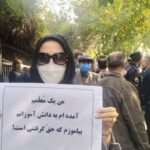

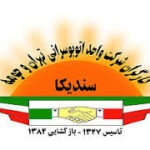

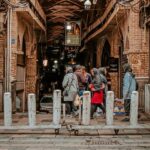
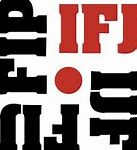



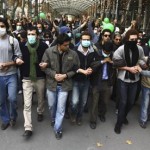
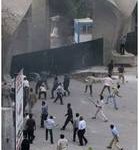
 Posted in
Posted in 